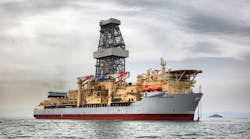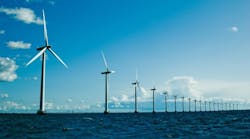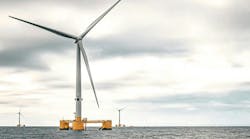Preparations are moving forward for the mammoth Johan Sverdrup project in theNorwegian North Sea. Statoil has awarded Aker Solutions an engineering services, procurement and management assistance contract encompassing front-end engineering design. According to partner Lundin Petroleum, details of the project scope will be issued following agreement on the final concept - these will include peak production capacity, likely capital costs, and timing of the various development phases.
If Norway's parliament sanctions the project in spring 2015, first production should be achievable at the end of 2019. The field, still undergoing appraisal drilling, contains estimated resources of 1.8-2.9 Bboe and could produce through 2050. Phase 1 will involve construction and installation of a four-field platform center, with oil sent through a new pipeline to the Mongstad terminal, western Norway, and gas through the Statpipe subsea trunkline system to Kaarstø. Partner Det Norske Oljeselskap believes first-phase investments could amount to $16-21 billion.
Close to the North Sea Oseberg complex, Statoil has proven 19-44 MMboe of oil and gas via wells on the Askja East and West prospects drilled by the semisubOcean Vanguard. The company is considering a joint development with its 2011 Krafla and Krafla West discoveries south of Oseberg, thought to hold 50-75 MMboe recoverable.
One option could be a tieback to the Oseberg South platform - Statoil's stated goal is to keep the Oseberg complex in business through 2040 via a variety of measures. These include a new Category J rig that will drill wells on existing templates for exploration and field development purposes.
UK development set to dip, report suggests
Last year was a mixed bag for UK upstream E&P, according to analysts Wood Mackenzie. Capital investment reached the highest level in real terms since the mid-70s, driven largely by a series of major field developments and redevelopments. However, soaring services costs also put pressure on project economics, causing Chevron's Rosebank and Statoil's Bressay in the Shetlands area to be put on hold pending review.
Stretched resources also led to delays in some ongoing projects, with only 13 new fields entering production in 2013 against the 21 forecast at the start of the year. Head of UK upstream research Lindsay Wexelstein predicted a similar number would come online this year, but also foresaw a tail-off in development spending after 2015 due to disappointing recent exploration results.
Wood Mackenzie's review found that only 52 exploration and appraisal wells were drilled in UK waters last year, due to resource shortages and some companies' difficulties in raising funds to drill. Those wells that did go ahead only discovered a total of 79 MMboe of recoverable reserves. UK merger and acquisition activity was also relatively quiet, the analysts claimed, with assets traded totaling $1.7 billion in value, down from $9.6 billion in 2012.
However, two major deals did go through around the turn of the year. Hungary's MOL Group agreed to pay Wintershall $375 million for a package that includes 28 MMboe of 2P offshore reserves and equity stakes in the Catcher, Cladhan, and Scolty/Crathes developments. MOL, hitherto an onshore specialist in Eastern Europe and the Middle East region, will also acquire Wintershall's share of infrastructure in the Brent pipeline system and on the Sullom Voe terminal in Shetland.
Houston-based ATP Oil and Gas, which filed for bankruptcy in 2012, has sold its UK North Sea division to investment company Petroleum Equity for $133 million. ATP operates gas production in the UK southern North Sea, and had commissioned a Moss Maritime-designed floating, production, and storage platform for the Cheviot oilfield redevelopment in the northern North Sea. This was under construction at Cosco in China and Gulf Island Fabrication in the US until 2012 when all work, along with subsea and drilling contracts, had to be put on hold. ATP's UK management has been retained, and support from the new backer will allow work on Cheviot and other planned developments to go forward.
GDF Suez switches on Orca, Juliet
GDF Suez E&P UK has brought onstream its first two operated UK gasfield developments. Juliet, which the company discovered in late 2008, is 39 km (24 mi) from the English east coast in block 47/14-b. Production from two subsea wells, connected to a seafloor manifold, is sent through a new 22-km (13.7 mi) pipeline to Perenco's Pickerill A platform, and from there through an existing pipeline system to the Theddlethorpe processing terminal. GDF Suez estimates reserves in the Rotliegendes Leman sandstone reservoir at 11.6 MMboe.
The Orca field development is the second on the UK/Dutch median line, after LASMO's Markham. Gas from the Carboniferous reservoir flows from two wells drilled from the D18a-A production platform in 45 m (147 ft) of water on the Dutch side, 500 m (1,640 ft) from the border. A third well should enter production this month, allowing output to rise at peak to 1.5 MMcf/d from the Carboniferous reservoir. The gas is piped to the D15a-A platform for processing before heading though the NGT subsea trunkline system to Uithuizen, the Netherlands.
Various prior operators had attempted to develop Orca, which was discovered in 1993, but were defeated by project economics. According to analysts BritBoss the field presents technical challenges, including reservoir complexity and poor-quality gas, with a 20% inert gas content. Orca also covers a large area, extending into three blocks and part-blocks involving three licenses. Dirk Schoene, managing director of partner RWE Dea UK, said the cross-border location, the need to accommodate the two countries' different legal systems, and the distribution of resources across the licenses all entailed extensive negotiations.
New players drawn to Denmark
Dana Petroleum is set to operate Danish North Sea license 12/06, containing the 2011 Lille John oil and Broder Tuck gas condensate discoveries. The company has offered $44-million to PA Resources (PAR) for a 40% operating interest in the concession and in German North Sea license B20008/73.
Assuming approvals, the new partners plan to drill an appraisal well this year on Lille John and to bid jointly for more acreage under Denmark's forthcoming 7th licensing round. According to PAR president Mark McAllister, the transaction should lead to operating synergies with Dana's assets in the northern Dutch offshore sector. These include the Hanze oil and gas production complex 50 km (31 mi) south of license 12/06.
ESP Oil & Gas, a subsidiary of London-based Nordic Energy has applied for an exploration and production license in the eastern part of the Danish North Sea, under Denmark's rolling "Open Door" licensing procedure. The 1,750-sq km (675-sq mi) concession covers eight blocks next to license 1/13, which ESP acquired last September. It contains numerous prospective play types, Nordic claimed.







